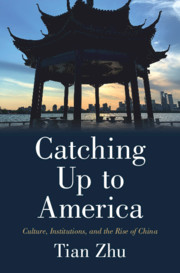Book contents
- Catching Up to America
- Catching Up to America
- Copyright page
- Dedication
- Contents
- Figures
- Tables
- Acknowledgments
- Abbreviations
- Introduction
- 1 Just How Rapid Is China’s Rise?
- 2 Explaining China’s Rise
- 3 Do Institutions Rule?
- 4 Savings and China’s Investment-Led Growth
- 5 The Role of Education
- 6 Technological Progress and Innovation
- 7 Confucian Culture as the Key Differentiating Factor
- 8 Why Is China Slowing Down?
- 9 Catching Up to America in a Post–COVID-19 World
- Appendix
- References
- Index
8 - Why Is China Slowing Down?
Published online by Cambridge University Press: 27 August 2021
- Catching Up to America
- Catching Up to America
- Copyright page
- Dedication
- Contents
- Figures
- Tables
- Acknowledgments
- Abbreviations
- Introduction
- 1 Just How Rapid Is China’s Rise?
- 2 Explaining China’s Rise
- 3 Do Institutions Rule?
- 4 Savings and China’s Investment-Led Growth
- 5 The Role of Education
- 6 Technological Progress and Innovation
- 7 Confucian Culture as the Key Differentiating Factor
- 8 Why Is China Slowing Down?
- 9 Catching Up to America in a Post–COVID-19 World
- Appendix
- References
- Index
Summary
After 2012, the Chinese economy entered a phase of declining growth. The GDP growth rate of 6.1 percent in 2019 just before the COVID-19 pandemic was the lowest in nearly thirty years. What caused the slowdown? Is the country falling into the so-called middle-income trap? These questions are addressed in Chapter 8. The chapter first shows why the “middle income trap” does not really exist and that before reaching high-income status, a country’s growth rate is unrelated to its income level. It then shows that China’s slowdown was mainly caused by a precipitous decline in investment growth. This decline was initially caused by the sweeping anti-corruption and anti-pollution campaign during 2013–2015. It was worsened by the misguided contractionary macroeconomic policies in 2016 and 2017 due to a mistaken belief by policymakers and economic commentators that China had invested too much and the corporate sector had piled up too much debt. In other words, China’s downturn before COVID-19 was not inevitable, and its economy could have grown faster.
Keywords
- Type
- Chapter
- Information
- Catching Up to AmericaCulture, Institutions, and the Rise of China, pp. 176 - 206Publisher: Cambridge University PressPrint publication year: 2021



